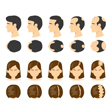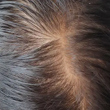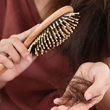Microneedling for Hair Loss
What is Microneedling? 1

Did you know that nearly 40% to 50% of people worldwide suffer from hair loss? Hair loss, irrespective of its cause, can be a harrowing experience. However, with the latest advances in dermatology and cosmetology, many medications and treatments can slow down or reverse hair loss. One such popular treatment is microneedling.
Microneedling is a minimally invasive procedure in which fine needles are used to puncture the topmost layer of the skin (called the stratum corneum) to induce collagen production and stimulate hair growth. Though relatively new with limited studies, microneedling has been used successfully with other hair growth therapies in people suffering from hair loss, including conditions like androgenic alopecia or male pattern of baldness.
What are the Benefits of Microneedling? 2,3,4
Microneedling was earlier used for scar treatment but was soon found to be effective as an alternative to hair growth treatments. Here are the benefits of microneedling that make it a preferred treatment choice for hair loss:
Reduced risk of infection
Since microneedling involves just the superficial layer of the skin, the procedure is not invasive. It promotes quick healing and reduces the risk of infection that is common with other hair transplant procedures.
Faster hair follicle stimulation
Research states that microneedling brings about faster follicle stimulation and is often recommended for patients with male pattern baldness.
Improves absorption of topical hair growth products like minoxidil
Studies have shown that microneedling increases the absorption of hair growth products containing topical steroids and platelet-rich plasma, all commonly used in treating hair loss. In a study conducted, microneedling devices like the dermaroller, when used with minoxidil, showed hair growth in men with androgenic alopecia.
Enhance growth factors that mediate hair follicle development
As discussed earlier, microneedling stimulates collagen fibers in the scalp and boosts blood circulation to the area. Studies have shown that microneedling also results in over expression of hair growth factors and induces stem cells in the hair follicles, which results in hair follicle development. As a result, microneedling can stimulate the production of new hair and reverse hair loss.
Side Effects and Risks Associated with Microneedling 5,6
The medical community considers microneedling a safe procedure. However, just like with all medical procedures, microneedling has its own side effects and risks. These include:
- Skin irritation
- Swelling
- Discomfort at the site
- Redness and bruising
- Dryness and flaking of the skin
- Pigmentation at the procedural site
- Folliculitis
- Tightness and peeling of the skin
Bleeding is an uncommon side effect of the microneedling procedure but may occur in people with bleeding disorders when the procedure goes deeper into the skin.
Other less common risks of microneedling include:
- Infection
- Changes in the skin pigment
- Adverse reactions to the topical medications used along with microneedling
To avoid the side effects and risks of microneedling, there are some precautions that you can take.
People with the following conditions should not undergo microneedling:
- Those with an active infection
- Have active acne
- Have an unstable skin type
- People with keloid scars
Other safety tips to keep in mind before undergoing a microneedling procedure:
- Inform your doctor about your allergies to anesthetic or numbing agents that may be used before the microneedling procedure.
- Avoid microneedling if you have skin conditions like eczema or psoriasis.
- Ask your doctor about how the reusable parts of a microneedling device are cleaned and sanitized between patients.
The Dermaroller and Its Use in Microneedling 7

One of the tools used in microneedling is a dermaroller. It was initially used for treating scars, but it is now also used for hair loss treatment.
Microneedling is a short procedure performed at your dermatologist's office. First, the area is anesthetized for around 45 minutes using a topical anesthetic. After the area has been prepared, the dermaroller is rolled on the area for around 15 to 20 minutes in all directions. Instantly, small bleeding spots called petechiae appear. After treatment completion, the saline pads are applied to the area. Depending on the area that requires treatment, the microneedling procedure using a dermaroller can take 20 minutes.
Though dermarollers come in different depths, the right dermaroller depends upon the thickness of the area that needs to be worked upon. The typical dermaroller is drum-shaped with 192 fine microneedles placed in eight rows. These needles are 0.5-1.5 mm in length and 0.1 mm in diameter. Dermarollers used in dermatology are single-use only and are pre-sterilized by gamma radiation. If you require subsequent dermaroller sessions, your doctor may recommend a minimum of six weeks between two treatments.
Since dermarollers have some risks, dermarollers are not recommended as a daily treatment.
Conclusion
Microneedling is becoming increasingly popular as a treatment for hair loss. Though the research about their effectiveness is still under study, the limited literature around them suggests that they have achieved great success in stimulating hair growth. Advanced tools like dermarollers have been used along with topical medications like minoxidil, and the combination is a popular one among those suffering from androgenetic alopecia.
Myth Busters HairFall

Androgenetic Alopecia - Everything You Need To Know
Have you been experiencing excessive hair fall over a prolonged period of time? It could be an early sign of androgenetic alopecia. It is a hair loss disorder common in both genders and can lead to progressive thinning and even baldness in some patients if not caught and treated early.

How To Make Hair Grow Faster For Men
A head full of healthy hair is a matter of confidence. Hair has its own mechanism of growing and shedding, and it is when this mechanism is thrown off that growth is hindered. Especially in the case of males, hair growth faces a lot of hiccups that can easily be managed.

Female Pattern Baldness - Causes & Treatments
Have you suddenly noticed an increase in the number of hair strands on your pillow in the morning? Or is your ponytail getting thinner by day? Well, you might be suffering from female pattern baldness. While that does sound scary, identifying it early on is key to treating this condition effectively. So keep reading to know what this is, how you can identify it, and most importantly, what treatments you can avail of to get your beautiful lustrous hair back.

What Are The Reasons For Hairfall?
Almost everyone experiences some amount of hair thinning over the years. Shedding around 50 to 100 single strands of hair per day is considered normal. However, losing more than 150 strands a day, experiencing sudden thinning, or developing circular bald patches on your scalp are reasons for concern. Hair loss occurs when new hair doesn’t grow fast enough to replace the amount of hair you lose daily. Hair can fall due to various reasons, with hereditary hair loss and poor nutrition being the most common hair fall reasons.

Expert Approved Tips For Hair Growth
What can be more debilitating than seeing hundreds of hair strands shedding from your scalp every time you brush your hair? Also, excessive molting occurs during seasonal changes that can be very stressful for you. Although it’s okay to lose between 50-100 strands every day, according to the American Academy of Dermatology, the problem occurs when you start shedding more than normal. But that doesn’t mean you have to feel helpless as there are ways to grow your hair back. Even if you are coping with baldness or alopecia, certain hair growth tips from dermatologists can come to your rescue. Read on to discover how these tips can be your savior when abnormal hair fall problems are in sight.
Trending Videos
+ 7 Sources
'LMRC - GGI-CO-A2-DMA-300001252-300001252-WM-L21-704'
© 2021 Dr. Reddy’s Laboratories Ltd. All rights reserved.